Gluten-Free Focaccia with Rosemary
This post may contain affiliate links. Please read our disclosure policy
Our easy gluten-free focaccia recipe has a perfect crispy crust & tender, fluffy center. It’s the easiest gluten-free bread around! (Vegan-Friendly!)
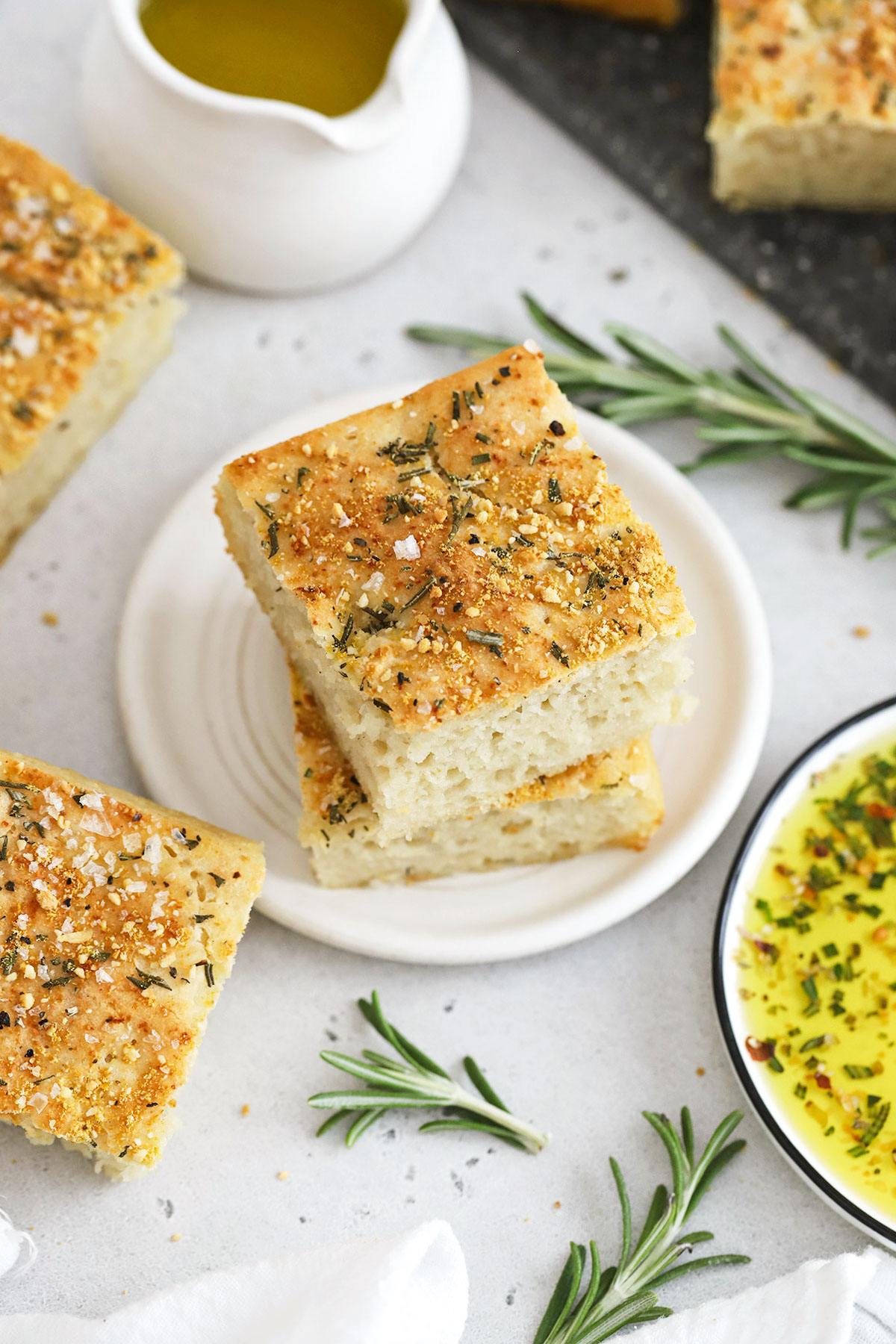
This gluten-free rosemary focaccia has been one of our top posts for the last several years, and it’s better than ever, thanks to updated, more thorough directions & helpful tips!
Before we went gluten-free a decade ago, I used to bake bread all the time. But gluten-free bread is a totally different ballgame! Since there’s no gluten, gluten-free bread dough can be trickier to work with and takes a little extra skill & know-how to get just right.
But do you know what’s probably the easiest gluten-free bread recipe around? Focaccia! This gluten-free focaccia bread recipe has a crisp, golden top and bottom, a soft & pillowy center, and just the right seasonings. It’s enough to send me into a swoon!
If you’re new to gluten free baking or haven’t made gluten-free bread recipes before, don’t worry! We’ve got everything you need to be successful. You’ll be baking loaf after loaf of this delicious Italian bread in no-time!
Lets jump in, yes? The carbs are calling!
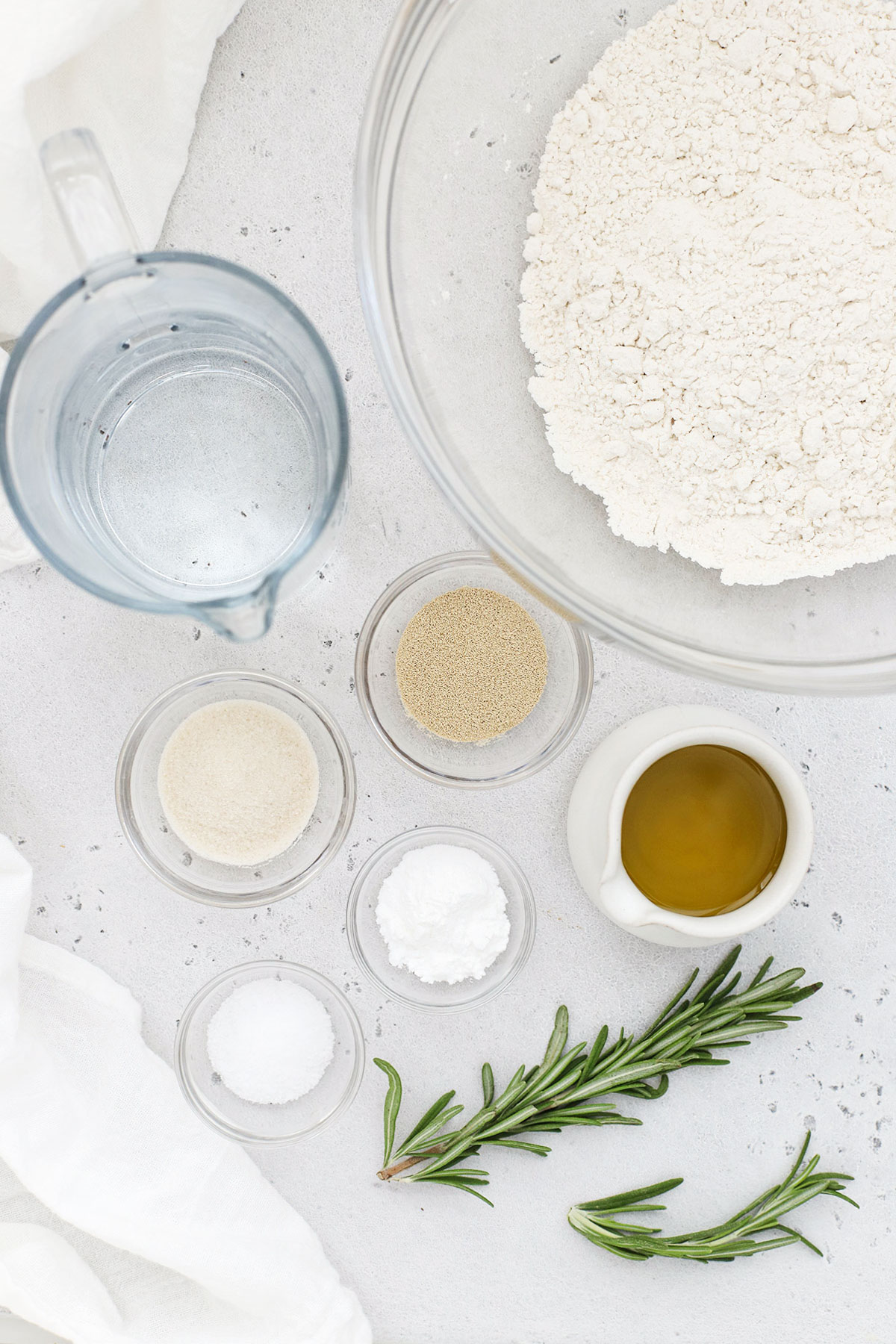
Simple Ingredients For Gluten-Free Focaccia:
- Gluten-Free Flour. You’ll keep things simple with a 1:1 gluten-free flour blend. We HIGHLY RECOMMEND King Arthur Measure For Measure Baking Flour with xanthan gum because it gets nice and golden on top and has the best texture inside. I have also tried it with Bob’s Red Mill 1-to-1 gluten free baking flour with decent results, though the Bob’s Red Mill blend usually doesn’t get quite as crisp or “done” as the King Arthur Blend, and some readers report their focaccia stays wet or gummy in the center when they use the Bob’s Red Mill blend.
- Baking Powder & Salt. Using baking powder with the yeast gives this focaccia a little extra lift and really improves the texture. Then, salt comes in to make the flavor amazing!
- Warm Water. Ideally, the water will be between 120-130 degrees to help activate the yeast. I recommend an instant read thermometer for best results, but you can use the touch test, too. If the water is too warm to comfortably keep your finger in it for a few seconds, it’s too hot!
- Honey or Sugar. Adding a little honey or sugar not only helps with the flavor of this bread, but it also helps activate the yeast. Don’t skip it!
- Active Dry Yeast. We’ve made this with instant yeast and regular yeast. Instant yeast will bloom and rise faster (great when you’re short on time!), and regular dry yeast works well, too.
- Olive Oil. You’ll need plenty of extra virgin olive oil for this focaccia recipe! You’ll use some in the dough, some on the pan, some on top, and some to dip!
- A Few Toppings. Then, you’ll top the focaccia with a few little extras before baking. I like a mix of fresh rosemary, parmesan cheese (or vegan parmesan cheese), flaky salt, and black pepper.
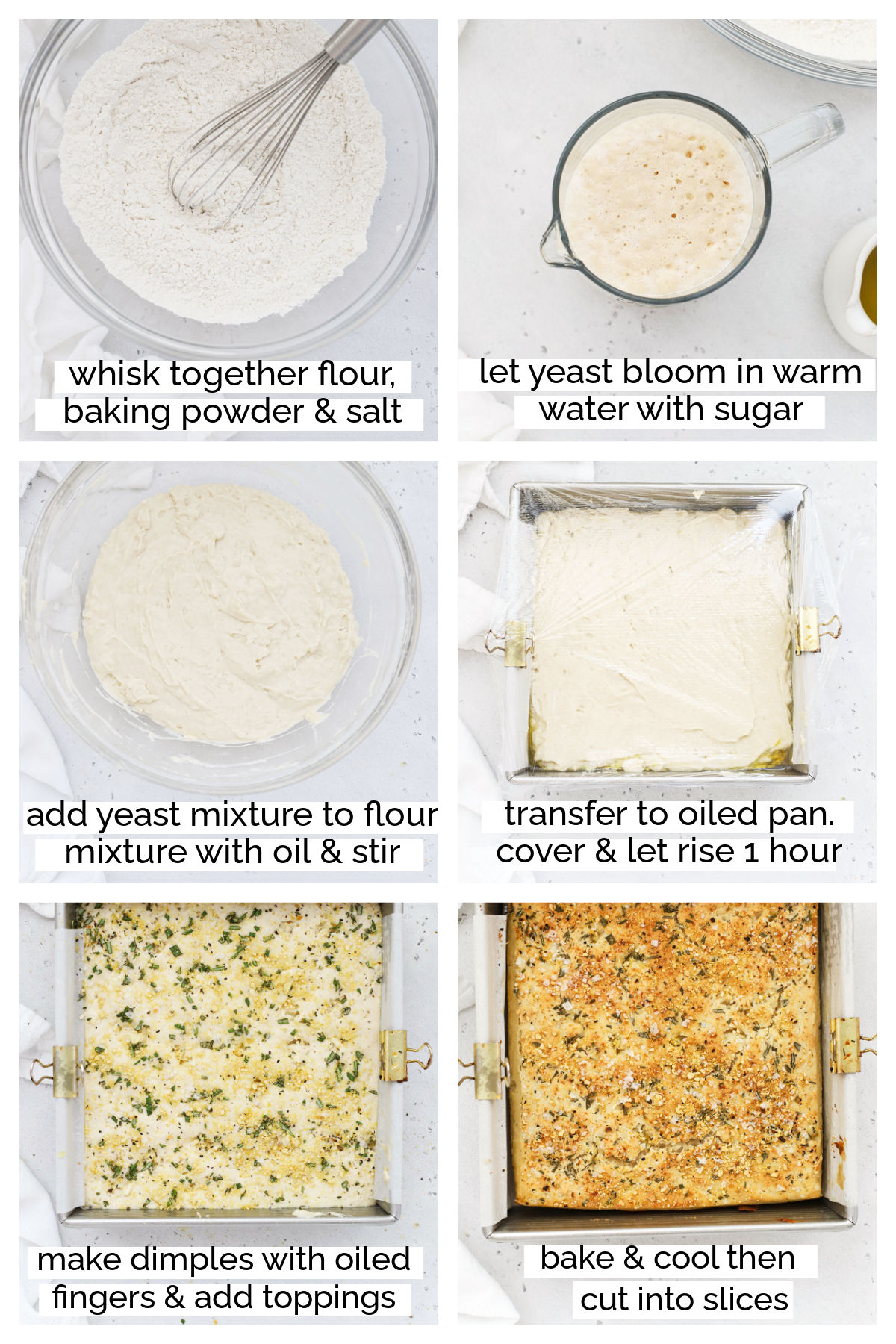
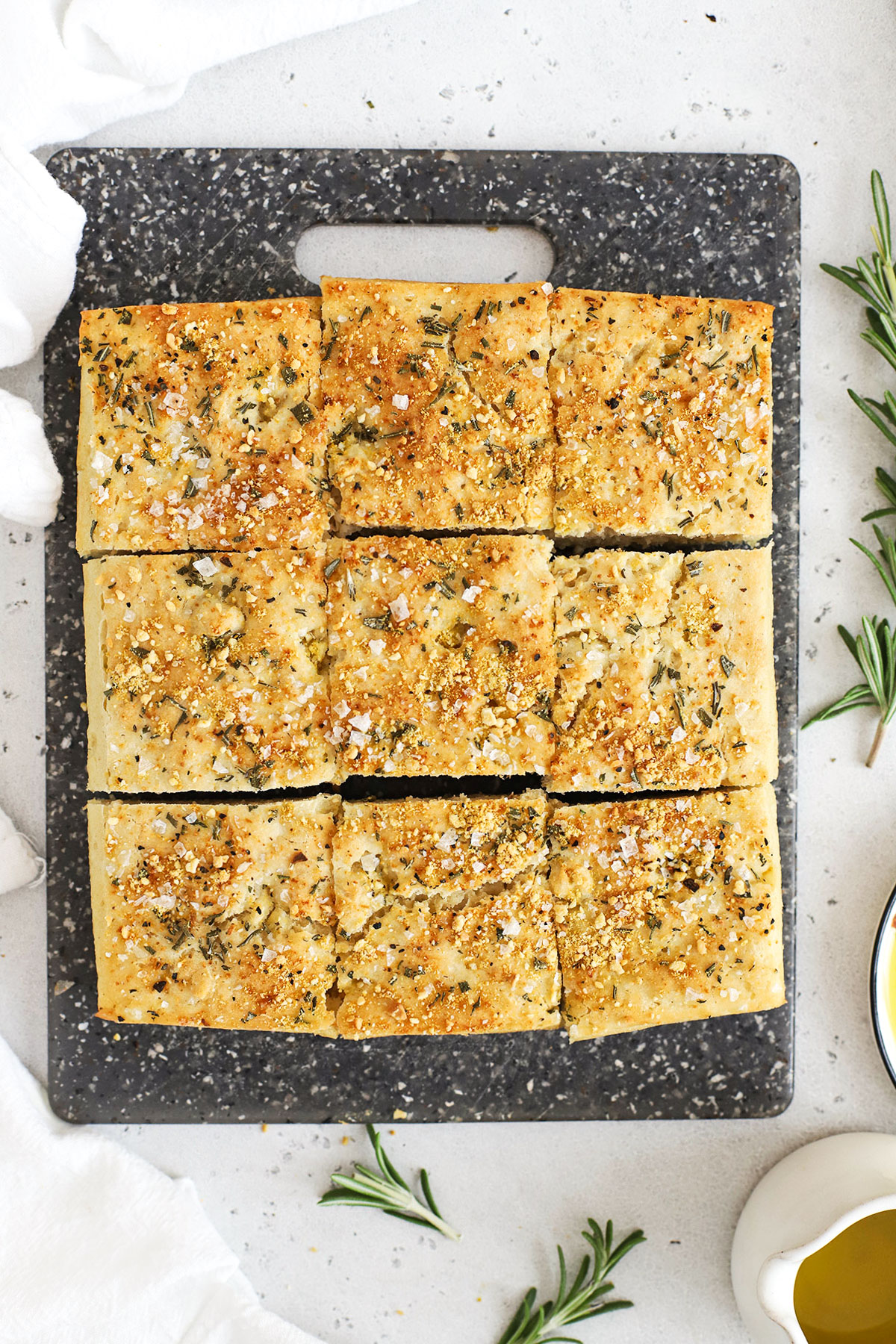
How To Make Gluten-Free Focaccia Step By Step:
- Combine Dry Ingredients. In a large mixing bowl, whisk together flour, salt, and baking powder. Set aside.
- Warm The Water. Warm your water in the microwave or on the stovetop until it’s warm but not hot. (Ideally, the temperature should be between 120-130 degrees F, but you can use the touch test to tell if it’s ok. If the water is too warm to put your finger in comfortably for several seconds, it’s too hot)
- Bloom The Yeast. Add yeast and honey or sugar to the warm water. Stir to combine, then let it bloom by setting it aside to rest for for 3-5 minutes. (It’ll start to look foamy on top)
- Combine Wet Ingredients & Dry Ingredients. Pour 2 Tablespoons olive oil and the the water/yeast mixture over the flour mixture and stir to combine. Note that the dough will actually be more like batter than dough. You will not knead it.
- Transfer To The Pan. Line an 8×8 or 9×9 metal baking pan with parchment paper. Drizzle 2-3 Tablespoons of olive oil onto the parchment. Gently transfer the focaccia dough to the pan and pat it out or spread it with a spatula. (I usually find it easiest to dip my fingertips into the oil and pat it out by hand). Drizzle the top of the dough with 1 more Tablespoon of olive oil.
- Let The Dough Rise. Cover the pan with plastic wrap or a clean dish towel and set it to rise in a warm place for at least 30 minutes if using rapid rise yeast and about an hour if you use regular yeast. The batter/dough will be roughly double in size.
- Preheat The Oven. During the last 20 minutes of the rise time, preheat the oven to 400 degrees F.
- Dimple The Dough. Coat your fingertips with olive oil and use greased fingers to poke several holes in the dough to form the characteristic “dimples” of focaccia. I find this easiest if I drizzle the surface of the dough with a little olive oil first, then use my fingertips to gently spread the oil before making the dimples. (Try not to smash the dough down)
- Add Toppings. Sprinkle the surface of the dough with fresh rosemary, parmesan or vegan parmesan (if using), coarse sea salt and pepper.
- Bake at 400 degrees 25-30 minutes, or until golden brown. Remove from oven and let cool at least 10-12 minutes before slicing and eating. Store leftover focaccia in an airtight container at room temperature 2-3 days, or store in the freezer and freeze up to 2 months.
ANOTHER OPTION FOR SHAPING: We used to make this rosemary focaccia free-form, by letting the dough rise in a bowl, then pouring it out onto a parchment lined baking sheet on top of 2 Tablespoons of olive oil. I’d shape the dough into roughly an 8×10 shape, then top and bake as directed. This will give you a more organic look, but the focaccia will be much thinner. In the last few years, I’ve exclusively made it in a square pan for a higher rise.
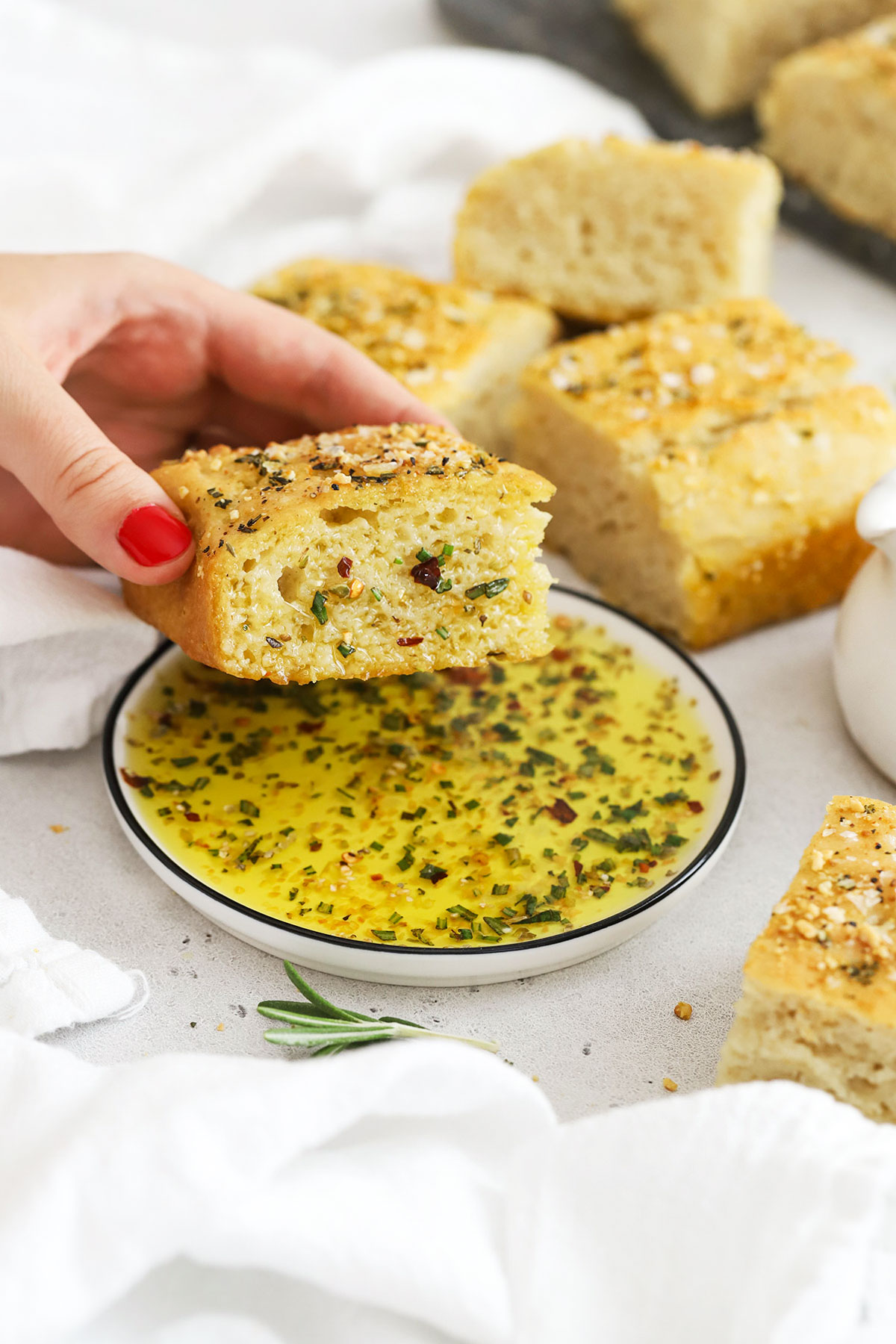
A Few Tips To get This recipe Just Right:
Use Fresh Ingredients
It might seem silly, but it’s important to know you’re using fresh ingredients. If you’re using old baking powder or old yeast, this bread WILL NOT rise no matter what you do. Use this quick test to check your baking powder to see if it’s still active, and watch for the foaming, bubbling reaction in the recipe instructions to make sure your yeast is still active.
Know How To Handle The Dough
If you’ve ever baked with wheat-based flours (white all-purpose, wheat, bread flour, etc.) you’ll be able to tell right away that gluten-free focaccia “dough” is really more like batter. It’s not pliable (there are no gluten or wheat proteins to give it that structure!), and you won’t knead it–you can’t! It’ll be a rather sticky, wet batter instead of a cohesive, stretchy dough. Don’t panic, and DON’T add extra flour!
Use Parchment On Your Pan
Your gluten-free focaccia batter will be sticky, and it can stick to the baking sheet if you don’t prep it. A surefire way to keep your dough from sticking to the pan is to use parchment paper, then drizzle the olive oil on top of it, as directed. I highly recommend you don’t skip the parchment. If you don’t like using parchment paper, at least use a reusable silicone baking mat to help prevent sticking.
Don’t Skimp On Olive Oil. Seriously.
Don’t do it! I know it’ll feel like a lot (especially on the baking pan), but I promise the olive oil is essential for the texture of the interior and exterior of gluten-free focaccia bread. Olive oil helps give that gorgeous crispy crust on the exterior and keeps things light on the interior. I promise your results will not be as good if you try to skimp on the olive oil. It’ll be more dry and spongy. And it won’t get the same gorgeous color. Trust me!
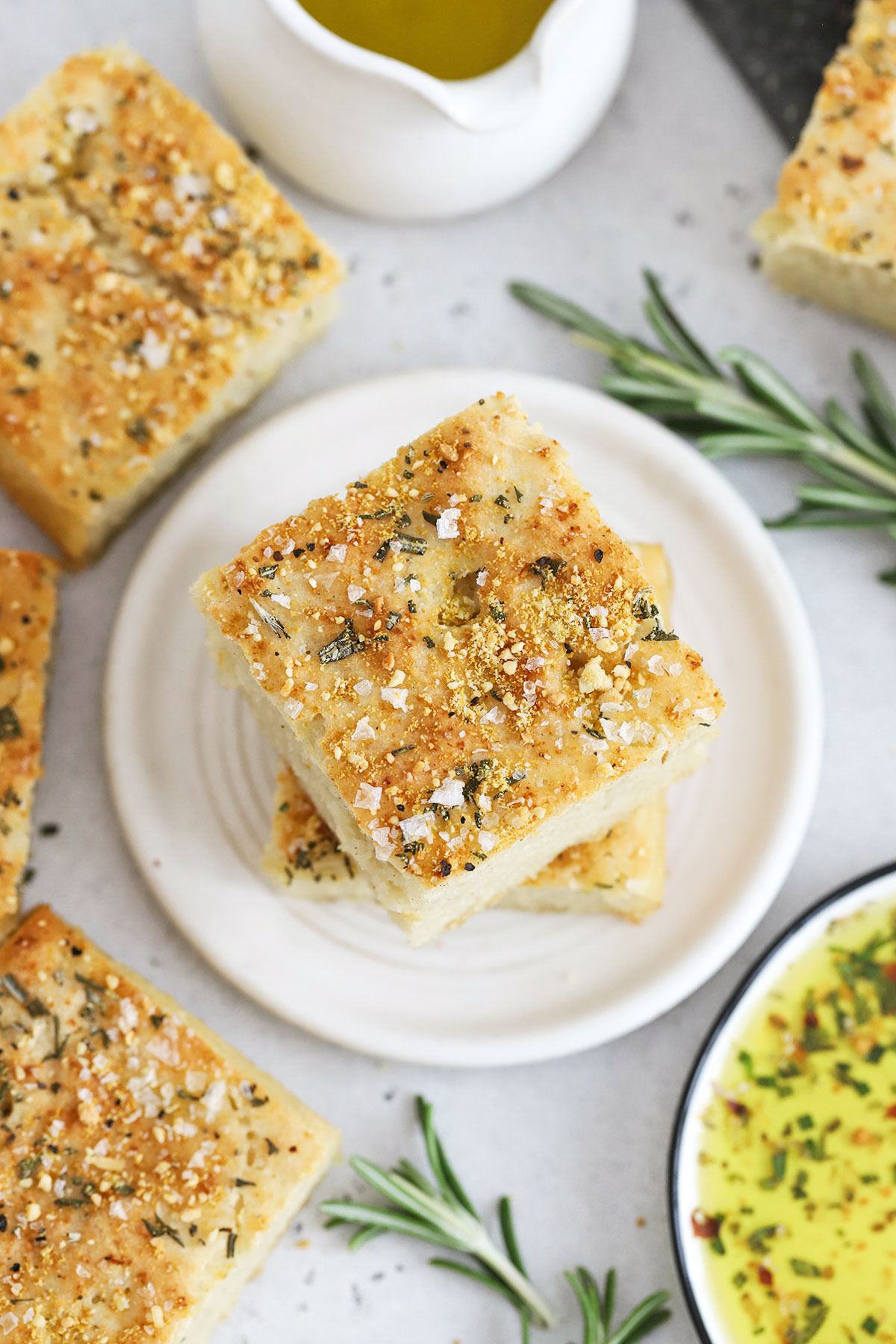
FAQ + MORE IDEAS FOR THIS GLUTEN-FREE FOCACCIA
HOW TO SERVE FOCACCIA – I’ve got to say it: my favorite way is when it’s burn-your-mouth hot from the oven. But. After it’s had enough time to actually cool down somewhat, my favorite way to enjoy gluten-free focaccia is dipped in olive oil. We love to make a seasoned dipping oil to serve with it! (It’s also great with marinara sauce!)
HOW TO STORE FOCACCIA – Like most gluten free baked goods, this gluten-free focaccia bread is best enjoyed in 1-2 days. I store mine wrapped tightly or in an airtight bag with extra air pressed out in the refrigerator, then heat it up in the oven (you can use the microwave or a toaster oven) before serving again.
MORE FOCACCIA TOPPINGS TO TRY. Part of what’s so fun about making this focaccia is choosing the toppings! Since this recipe was originally published in 2019, I’ve had dozens and dozens of readers send me their focaccia photos! Play around with the toppings! Readers have tried:
- Sun-Dried Tomatoes
- Caramelized Onions
- Roasted Garlic
- Olives – black, green, Kalamata, Castelvetrano, etc.
- Edible Flowers
- Fresh Herbs – sage, basil, rosemary, dill, parsley, thyme, etc.
- Dried Herbs & Spices – dried oregano, Italian seasoning, dried basil, red pepper flakes, etc.
- Different cheeses – asiago, parmesan, aged white cheddar, and more!

What To Serve With This Yummy Bread:
⭐ Don’t forget to leave a star review and comment below when you make our Gluten-Free Focaccia recipe. I can’t wait to hear how it goes!
Print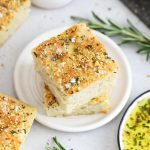
Gluten-Free Focaccia with Rosemary
- Total Time: 1 hour 40 minutes
- Yield: 9–12 slices 1x
- Diet: Gluten Free
Description
Our easy gluten-free focaccia recipe has a perfect crispy crust & tender, fluffy center. It’s the easiest gluten-free bread around! (Vegan-Friendly!)
Ingredients
For Gluten Free Focaccia:
- 2 1/2 cups (300 grams) gluten free 1:1 flour (I highly recommend King Arthur Flour Measure-for Measure flour)*
- 2 teaspoons baking powder
- 1 1/2 cups warm water (ideally 120–130 degrees F.)
- 1 (1/4 oz.) package instant or rapid rise yeast (2 1/4 teaspoons)
- 1 Tablespoon sugar, honey, or agave
- 1 teaspoon kosher salt
- 4 Tablespoons olive oil, divided
For Topping:
- 1 Tablespoon fresh rosemary
- 1–2 Tablespoons vegan parmesan or Parmesan cheese
- 1/2 teaspoon flaky sea salt (like Maldon)
- 1/4 teaspoon black pepper
Instructions
-
Combine Dry Ingredients. In a large mixing bowl, whisk together flour, salt, and baking powder. Set aside.
-
Warm The Water. Warm your water in the microwave or on the stovetop until it’s warm but not hot. (Ideally, the temperature should be between 120-130 degrees F, but you can use the touch test to tell if it’s ok. If the water is too warm to put your finger in comfortably for several seconds, it’s too hot)
-
Bloom The Yeast. Add yeast and honey or sugar to the warm water. Stir to combine, then let it bloom by setting it aside to rest for for 3-5 minutes. (It’ll start to look foamy on top)
-
Combine Wet Ingredients & Dry Ingredients. Pour 2 Tablespoons olive oil and the the water/yeast mixture over the flour mixture and stir to combine. Note that the dough will actually be more like batter than dough. You will not knead it.
-
Transfer To The Pan. Line an 8×8 or 9×9 metal baking pan with parchment paper. Drizzle 2-3 Tablespoons of olive oil onto the parchment. Gently transfer the focaccia dough to the pan and pat it out or spread it with a spatula. (I usually find it easiest to dip my fingertips into the oil and pat it out by hand). Drizzle the top of the dough with 1 more Tablespoon of olive oil.
-
Let The Dough Rise. Cover the pan with plastic wrap or a clean dish towel and set it to rise in a warm place for at least 30 minutes if using rapid rise yeast and about an hour if you use regular yeast. The batter/dough will be roughly double in size.
-
Preheat The Oven. During the last 20 minutes of the rise time, preheat the oven to 400 degrees F.
-
Dimple The Dough. Coat your fingertips with olive oil and use greased fingers to poke several holes in the dough to form the characteristic “dimples” of focaccia. I find this easiest if I drizzle the surface of the dough with a little olive oil first, then use my fingertips to gently spread the oil before making the dimples. (Try not to smash the dough down)
-
Add Toppings. Sprinkle the surface of the dough with fresh rosemary, parmesan or vegan parmesan (if using), coarse sea salt and pepper.
-
Bake at 400 degrees 25-30 minutes, or until golden brown. Remove from oven and let cool at least 10-12 minutes before slicing and eating. Store leftover focaccia in an airtight container at room temperature 2-3 days, or store in the freezer and freeze up to 2 months.
Our original instructions called for making this focaccia free-form on a baking sheet. This produces a more organic shape, but a thinner dough. If you prefer to follow the old instructions, mix up the dough as directed, but let the dough rise in the mixing bowl covered with plastic wrap. Pour 2 Tablespoons of olive oil on a baking sheet lined with parchment and shape the dough into an 8×10 rectangle. Top & bake the bread as directed.
Notes
CHOOSE THE RIGHT FLOUR. I *highly* recommend King Arthur Flour Measure-for-Measure flour for this recipe. Bob’s Red Mill 1:1 flour is my other favorite, but will not get as light, as browned, or as “done” in the center as King Arthur Flour. Some readers report their focaccia stays wet or gummy in the center with Bob’s.
FOR A YUMMY DIPPING SAUCE: Pour 1/3 cup olive oil over granulated garlic, coarse salt, pepper, red pepper flakes, and rosemary, oregano, and/or basil. I usually use 1/4 tsp dried flaked garlic, 1/2 tsp fresh rosemary, 1/4 tsp oregano, 1/4 tsp coarse salt, 1/4 tsp pepper, and 1/4 tsp red pepper flakes
- Prep Time: 15 minutes
- Rise time: 1 hour
- Cook Time: 25 minutes
- Category: Side dish
- Method: Baking
- Cuisine: Italian
Originally posted June 2019. Fully updated with video, photos, and updated instructions Aug 2023.





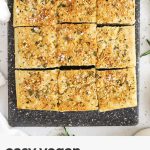
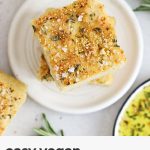
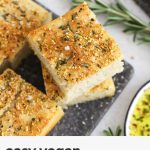
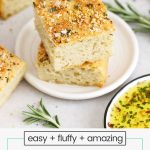
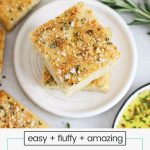
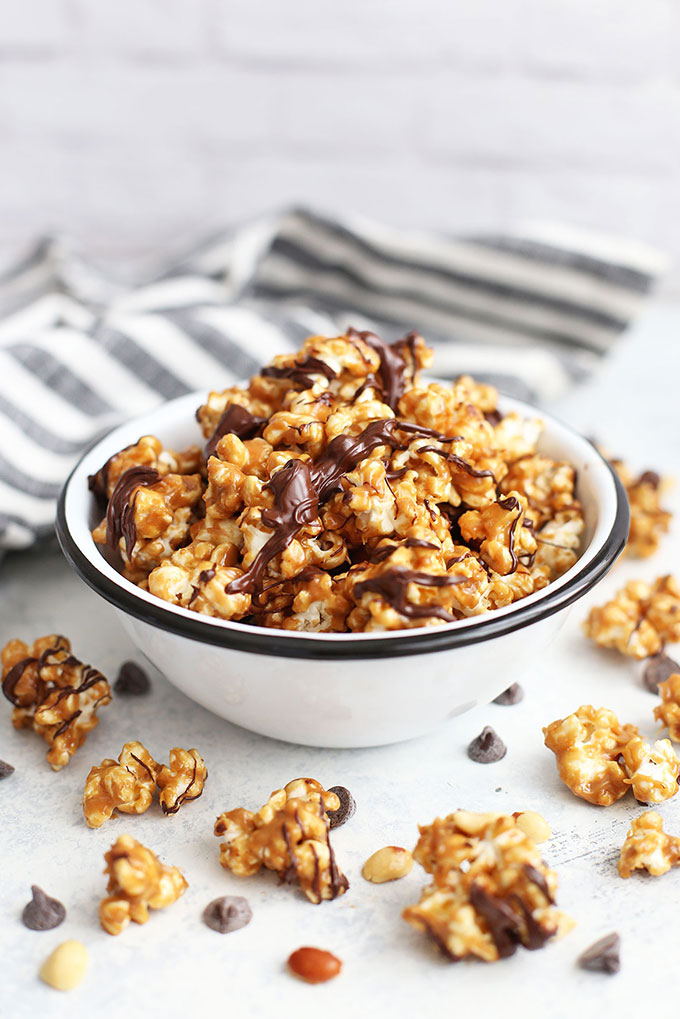
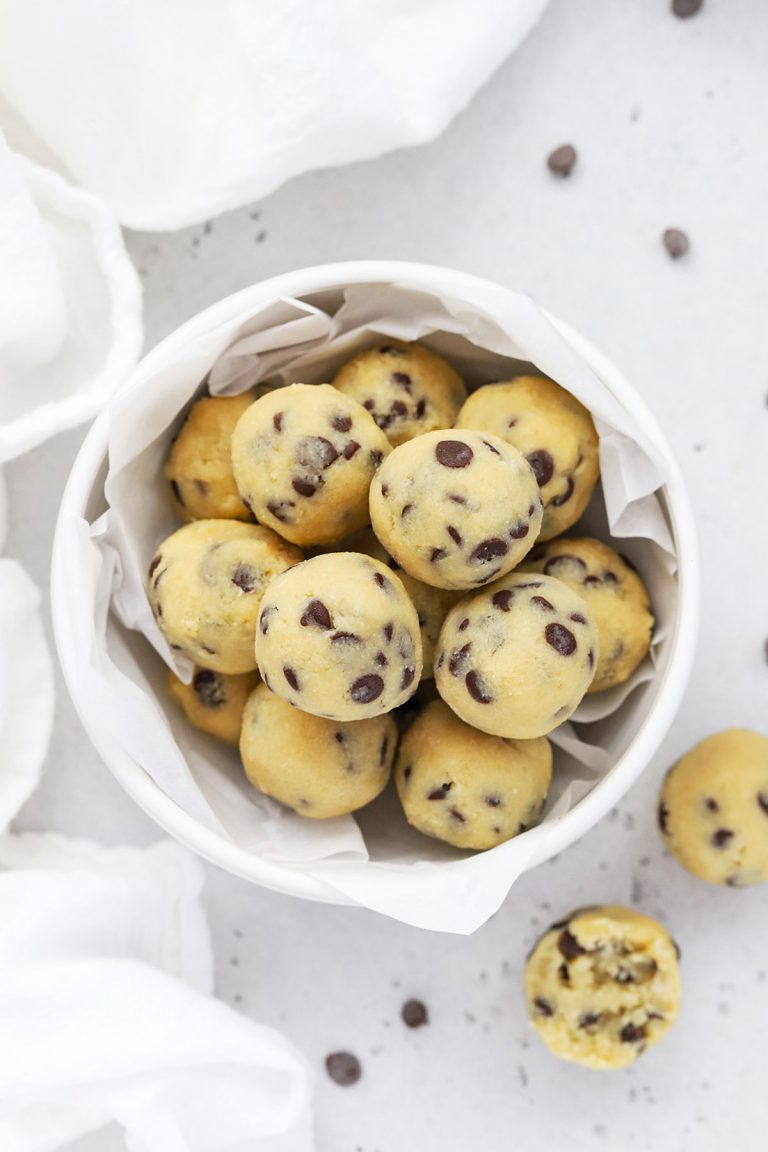
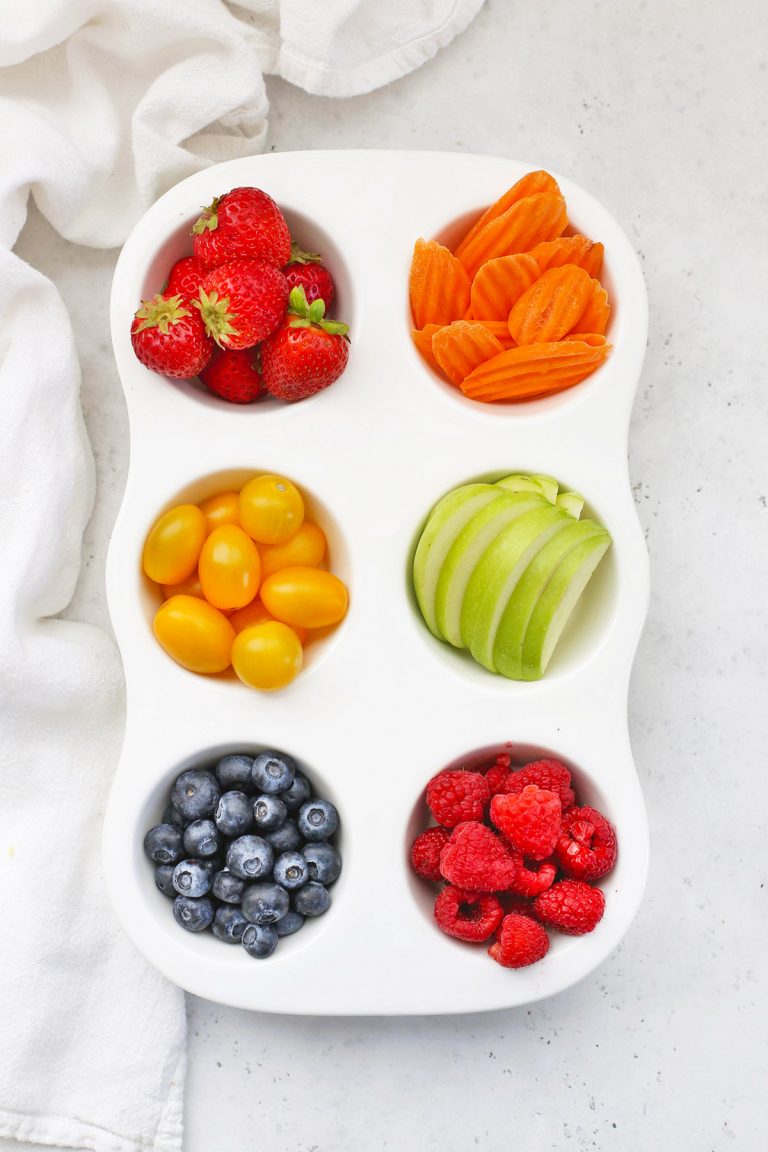
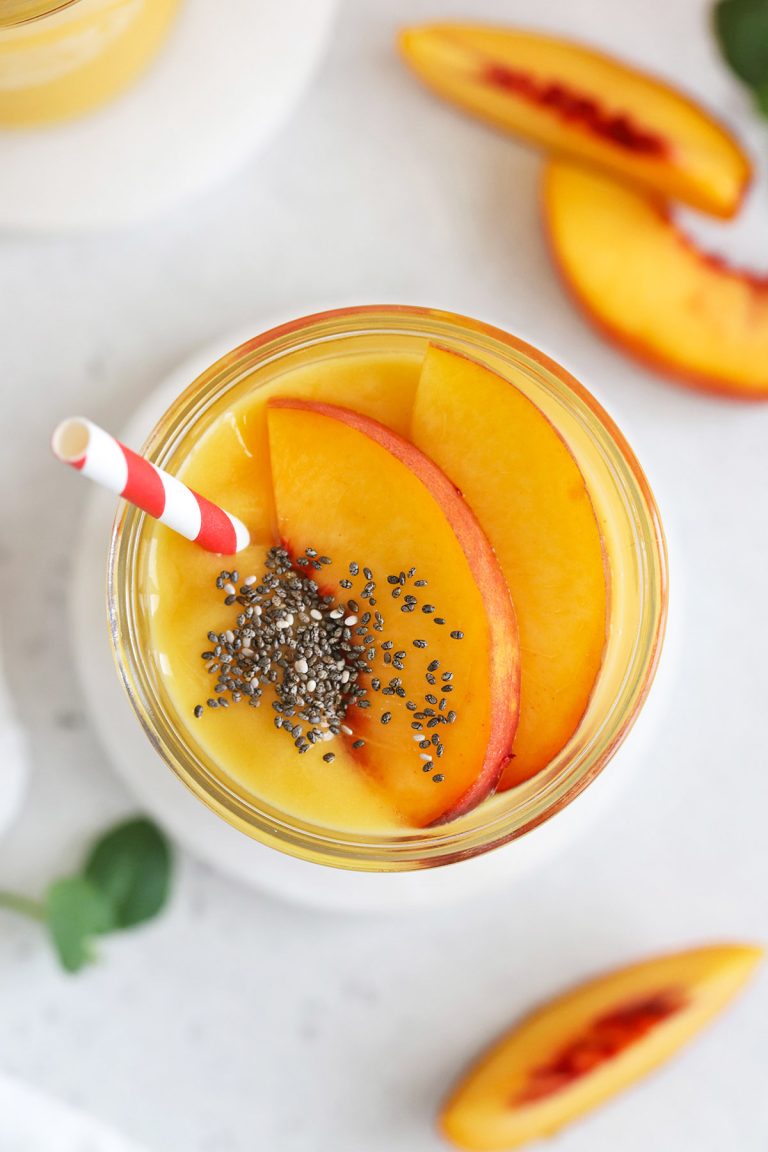


Can I leave out the sugar? I don’t have any sugar, honey, or any sweetener handy, so will the yeast still activate with just warm water?
Thanks for the recipe! Can’t wait to try!
Jen – Totally understand. You can risk it if you like, but it may not turn out the same. Sweetener helps activate the yeast, which can be helpful with gluten-free bread baking (which is notoriously finicky). Traditional bread recipes do without sugar regularly, so it might work? I just can’t guarantee the results without having tried it first. I’m sorry!
It turned out great! I decided to give it a try yesterday, and the focaccia is almost gone and it has only been 24 hours! My husband and daughter loved it.
Thanks again!
Jen – Oh GOOD! I’m SO glad it turned out for you!!! That’s fantastic!
I made this recipe with Bob’s Red Mill 1-to-1 gluten free baking flour. Unfortunately, it appears that both Bob’s 1-to-1 and King Arthur’s Measure-for-Measure have Xanthan gum in the mixes. That means this focaccia comes out rather chewy and not really focaccia textured. That said, this came out about as good as the focaccia other GF restaurants serve. I think next time I might use a little more yeast and baking powder to leaven it a bit more and mitigate the chewiness?
Ocean – I’m sorry it wasn’t quite what you were looking for. I’d love to know if your adjustments solve the problem for you!
Can I use GF all purpose flour?
I’ve only tested it with King Arthur Flour Measure for Measure and Bob’s Red Mill Measure-for-Measure, so I can’t 100% guarantee your blend if you choose to use a different one. If you give it a try, I’d love to know which one you use and how it goes!
This smelled delicious while baking- but unfortunately I had similar results to some others. I’m hoping maybe you have some suggestions so I can troubleshoot. I followed the recipe exactly and used Bob’s 1-1 mix. I spoon my gluten free flour into the measuring cups when I bake. The yeast was beautiful and frothy after 5 minutes, and the dough more than doubled in size after 30 mins in a warm spot. The batter/dough looked beautiful and I baked on a silicone mat in an 8×10 stainless steel water pan. The dough barely rose in the oven though and while it smells great, the inside is gummy/raw looking and textured. The outside is done but not really a full golden brown, more light. I baked for 30 minutes and am popping it back in for an extra 5. All of the ingredients I used were fresh as we bake a lot here. Thoughts?
Jacque – That’s so frustrating, I’m so sorry. It sounds like you did all the right things.
A few things I can think of that could possibly be at play here:
1. Oven temperature. Many (if not most) ovens vary from their stated temperature, so if you don’t have an oven thermometer, it might be worth looking into. (My current oven is 25 degrees below the stated temperature, for instance, so I have to compensate until my thermometer shows the correct temp.)
2. Altitude – Sometimes, if you’re at a high altitude that can impact a bake. Are you by chance at a high altitude?
3. Lastly, one other suggestion. Another reader who wanted a higher rise (and had a similar experience to yours) allowed hers to rise a second time (until it had doubled again) on the baking sheet before putting it in the oven. She said it made a huge difference in getting the height and “fluff” she was looking for. Maybe that would be worth trying?
Again, I’m so sorry you ran into trouble. Bread baking (especially gluten-free bread baking) is notoriously finicky, and I know how frustrating it can feel when a recipe doesn’t turn out. Wishing you ALL the best luck if you give it another go!
Thank you for the thoughtful tips! I tried putting it back in for another 20 minutes and despite the outside being super crunchy, the inside is still gummy and has a raw taste. An inaccurate oven temperature could definitely be a problem for us. I’ve noticed previously that it seems to run a little hot, and perhaps that is what I’m running into here. I’m also wondering if I did not mix long enough. I don’t have a stand mixer, so used a wooden spoon and just mixed until everything was well incorporated. Maybe if I try again I’ll mix longer and add a second rise. It looks so good and I would love to have some success with it. I’ll have to change a few things on my end and see how it goes. Thank you!
Fingers so crossed for you!
Made this with Bob’s Red Mill gluten free flour and it turned out awesome!
I used bread maker yeast and let it ride for about an hour on the stove (with some cookies in the oven.) The batter doubled in size.
Instead of a cookie sheet I used two cast iron pans (highly reccomend trying this!) I only put about an inch of batter in each and made sure they were well oiled.
Everybody loved it and it baked perfectly at 400 for 25 mins.
Kels – We made it in a cast iron pan a couple of weeks ago and it was DELICIOUS! I loved how crispy the bottom got! So glad you enjoyed it! 🙂
Emily, this bread was absolutely fantastic! I just made it for the first time and everyone in my family enjoyed it. I loved the texture and taste very much. Thank you for another winner recipe to go in my recipe book.
WONDERFUL!!! I’m so glad you liked it, Kristen! It’s our family’s favorite.
What a disappointment! I’m taking dinner to a family who just had a baby and the mother is celiac. The bread turned out gummy and raw inside. I am a chef by profession, but do not cook gluten free. I followed all instructions very carefully but this will have to go straight in the garbage! Now I don’t know what I’ll serve this family in 20 minutes. What a disaster!!!!!
Aubrey, I’m so sorry to hear this. That sounds SO frustrating. Gluten-free bread baking is definitely a different experience than traditional baking. Did you use King Arthur Flour measure-for-measure blend flour or another blend? Other flour blends will produce different results, which may have contributed to the gummy center. Again, so sorry it didn’t work out for you, especially since you were planning to bring it to a friend.
It’s been a long time since I made focaccia. I remember loving it with spaghetti and salad. I think I will make this tomorrow.
Hope it’s a huge hit!
Hi Emily,
Made this exactly how stated until the toppings. Used bread art ideas for toppings. Cooking time was longer, waited until the focaccia was browned on top. Erin DM’d you on Instagram with the pics. Ate the entire bread with dipping sauce for breakfast 10/10😍
The pictures were GORGEOUS!!! I LOVED how you were able to decorate it!
Made this today and can’t believe how well it turned out. Thank you!
I’m so glad you liked it! It’s our FAVORITE!
Oh my gosh! This is amazing! I just made it for dinner and I don’t want anything but this. Even my gluten eating husband said it was amazing- like real focaccia. LOL. The dimples didn’t come out well but who cares, its not ugly and the flavor makes up for it. If I could attach a picture, I would. Thank you!
WOW! That’s fantastic!!! I’m so glad.
Thank you, I made the recipe delicious and the ingredients are correct it’s really wonderful
So glad you enjoyed it Haya!
thank you for this recipe it turned out perfectly, i actually used a slight raised tray so it moulded nicely into it , can’t tell its gluten free…
Delicious !!!
Ooh–great idea! We made it in a cast-iron pan once and I loved how the crust turned out. 🙂
I am trying to make this right now, and I followed all the measurements, but it is SO liquid. It looks more like crepe batter than a thick pancake batter. I don’t know what the heck I did wrong. I used a kitchen scale to measure everything, so I am at a loss. I added more flour to thicken it before rising, so hopefully that does something? If not, I still have 5 hours before family dinner, so I can try again!
Fingers crossed!
Tsianina – Oh dear–My fingers are crossed for you! Out of curiosity, what brand of flour did you use?
Can’t rate yet, my first batch came out flat and gluey. However I did notice that the batter deflated quite a bit when I spread it on the plan. Thinking I should have let it rise again. Will try again
I’m sorry to hear that. I hope the second try is a HUGE win. (Out of curiosity, what kind of flour did you use?)